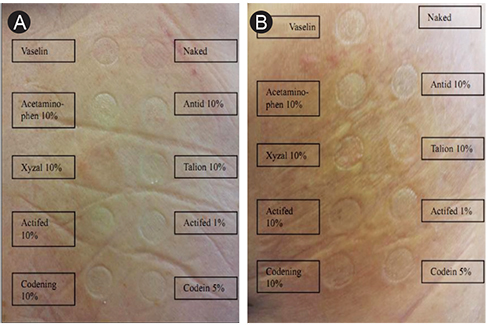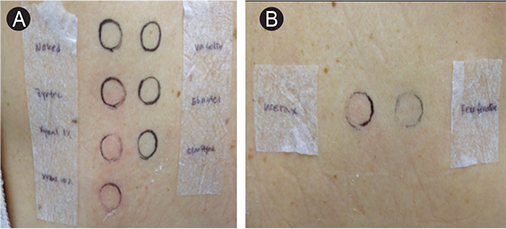Asia Pac Allergy.
2013 Oct;3(4):281-284. 10.5415/apallergy.2013.3.4.281.
A case of levocetirizine-induced fixed drug eruption and cross-reaction with piperazine derivatives
- Affiliations
-
- 1Department of Internal Medicine, Busan Paik Hospital, Inje University College of Medicine, Busan 614-735, Korea.
- 2Department of Internal Medicine, Pusan National University College of Medicine, Busan 602-739, Korea.
- 3Department of Internal Medicine, Seoul National University College of Medicine, Seoul 110-799, Korea. shkrins@gmail.com
- 4Institute of Allergy and Clinical Immunology, Seoul National University Medical Research Center, Seoul 110-799, Korea.
- 5Department of Internal Medicine, Seoul National University Bundang Hospital, Seongnam 463-707, Korea.
- KMID: 2397305
- DOI: http://doi.org/10.5415/apallergy.2013.3.4.281
Abstract
- Fixed drug eruption is an uncommon adverse drug reaction caused by delayed cell-mediated hypersensitivity. Levocetirizine is an active (R)-enatiomer of cetirizine and there have been a few reports of fixed drug eruption related to these antihistamines. We experienced a case of levocetirizine-induced fixed drug eruption and cross-reaction with other piperazine derivatives confirmed by patch test. A 73-year-old female patient presented with recurrent generalized itching, cutaneous bullae formation, rash and multiple pigmentation at fixed sites after taking drugs for common cold. She took bepotastine besilate (Talion®) and levocetirizine (Xyzal®) as antihistamine. She took acetaminophen, pseudoephedrine 60 mg / triprolidine 2.5 mg (Actifed®), dihydrocodeinebitartrate 5 mg / di-methylephedrine hydrochloride 17.5 mg / chlorpheniramine maleate 1.5 mg / guaifenesin 50 mg (Codening®) and aluminium hydroxide 200 mg / magnesium carbonate 120 mg (Antad®) at the same time. Patch test was done with suspected drugs and the result was positive with levocetirizine. We additionally performed patch test for other antihistamines such as cetirizine, hydroxyzine, fexofenadine and loratadine. Piperazine derivatives (cetirizine and hydroxyzine) were positive, but piperidine derivatives (fexofenadine and loratadine) were negative to patch test. There was no adverse drug reaction when she was challenged with fexofenadine. We report a case of levocetirizine-induced fixed drug eruption confirmed by patch test. Cross-reactions were only observed in the piperazine derivatives and piperidine antihistamine was tolerant to the patient.
Keyword
MeSH Terms
-
Acetaminophen
Aged
Carbon
Cetirizine
Chlorpheniramine
Common Cold
Drug Eruptions*
Drug-Related Side Effects and Adverse Reactions
Exanthema
Female
Guaifenesin
Histamine Antagonists
Humans
Hydroxyzine
Hypersensitivity
Loratadine
Magnesium
Patch Tests
Pigmentation
Pruritus
Pseudoephedrine
Triprolidine
Acetaminophen
Carbon
Cetirizine
Chlorpheniramine
Guaifenesin
Histamine Antagonists
Hydroxyzine
Loratadine
Magnesium
Pseudoephedrine
Triprolidine
Figure
Cited by 2 articles
-
Bepotastine-induced urticaria, cross-reactive with other antihistamines
Ju Wan Kang, Jaechun Lee
Asia Pac Allergy. 2016;6(4):253-256. doi: 10.5415/apallergy.2016.6.4.253.Self-report prevalence and associated factors to drug hypersensitivity in Mexican young adults
Martín Bedolla-Barajas, Cecilia Puente-Fernández, Miriam V. Flores-Merino, Jaime Morales-Romero, Ma. Victoria Domínguez-García
Asia Pac Allergy. 2017;7(3):156-162. doi: 10.5415/apallergy.2017.7.3.156.
Reference
-
1. Simons FE. Advances in H1-antihistamines. N Engl J Med. 2004; 351:2203–2217.
Article2. Assouère MN, Mazereeuw-Hautier J, Bonafé JL. [Cutaneous drug eruption with two antihistaminic drugs of a same chemical family: cetirizine and hydroxyzine]. Ann Dermatol Venereol. 2002; 129:1295–1298.3. Cohen HA, Barzilai A, Matalon A, Harel L, Gross S. Fixed drug eruption of the penis due to hydroxyzine hydrochloride. Ann Pharmacother. 1997; 31:327–329.
Article4. Cravo M, Gonçalo M, Figueiredo A. Fixed drug eruption to cetirizine with positive lesional patch tests to the three piperazine derivatives. Int J Dermatol. 2007; 46:760–762.
Article5. Dwyer CM, Dick D. Fixed drug eruption caused by diphenhydramine. J Am Acad Dermatol. 1993; 29:496–497.
Article6. Kränke B, Mayr-Kanhäuser S. Urticarial reaction to the antihistamine levocetirizine dihydrochloride. Dermatology. 2005; 210:246–247.
Article7. Mahajan VK, Sharma NL, Sharma VC. Fixed drug eruption: a novel side-effect of levocetirizine. Int J Dermatol. 2005; 44:796–798.
Article8. Barbaud A. Skin testing in delayed reactions to drugs. Immunol Allergy Clin North Am. 2009; 29:517–535.
Article9. Walsh GM. Levocetirizine: an update. Curr Med Chem. 2006; 13:2711–2715.
Article10. González de Olano D, Roán Roán J, de la Hoz Caballer B, Cuevas Agustín M, Hinojosa Macías M. Urticaria induced by antihistamines. J Investig Allergol Clin Immunol. 2006; 16:144–146.11. Schröter S, Damveld B, Marsch WC. Urticarial intolerance reaction to cetirizine. Clin Exp Dermatol. 2002; 27:185–187.
Article12. Afonso N, Shetgaonkar P, Dang A, Rataboli PV. Cetirizine-induced anaphylaxis: a rare adverse drug reaction. Br J Clin Pharmacol. 2009; 67:577–578.
Article13. Shiohara T. Fixed drug eruption: pathogenesis and diagnostic tests. Curr Opin Allergy Clin Immunol. 2009; 9:316–321.
Article14. White JM. Patch testing: what allergists should know. Clin Exp Allergy. 2012; 42:180–185.
Article15. Barbaud A, Gonçalo M, Bruynzeel D, Bircher A. Guidelines for performing skin tests with drugs in the investigation of cutaneous adverse drug reactions. Contact Dermatitis. 2001; 45:321–328.16. Pichler WJ, Tilch J. The lymphocyte transformation test in the diagnosis of drug hypersensitivity. Allergy. 2004; 59:809–820.
Article




